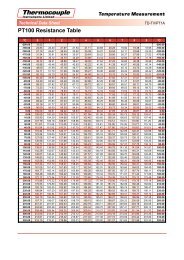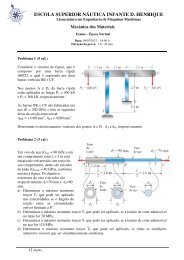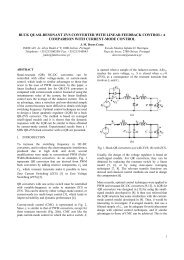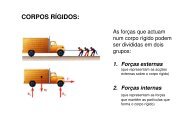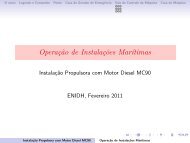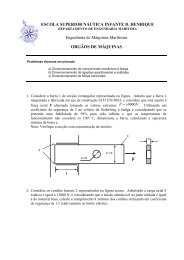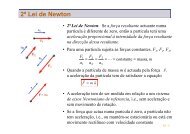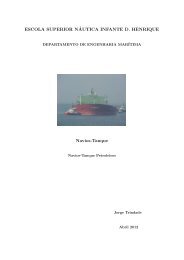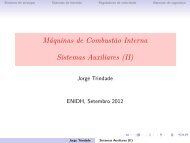Textos de Apoio (pdf)
Textos de Apoio (pdf)
Textos de Apoio (pdf)
Create successful ePaper yourself
Turn your PDF publications into a flip-book with our unique Google optimized e-Paper software.
vessel sails against the wind or waves,<br />
in shallow waters, when the hull is<br />
fouled, and when the ship accelerates.<br />
Un<strong>de</strong>r increased resistance, this involves<br />
that the propeller speed (rate of<br />
revolution) has to be increased in or<strong>de</strong>r<br />
to maintain the required ship speed.<br />
The real slip ratio will be greater than<br />
the apparent slip ratio because the real<br />
speed of advance V A<br />
of the propeller is,<br />
as previously mentioned, less than the<br />
ship’s speed V.<br />
The real slip ratio S R<br />
, which gives a truer<br />
picture of the propeller’s function, is:<br />
S<br />
R<br />
VA<br />
V w<br />
= −<br />
p× n<br />
= − × ( 1−<br />
)<br />
1 1<br />
p×<br />
n<br />
At quay trials where the ship’s speed is<br />
V = 0, both slip ratios are 1.0. Inci<strong>de</strong>ntally,<br />
slip ratios are often given in percentages.<br />
Propeller law in general<br />
As discussed in Chapter 1, the resistance<br />
R for lower ship speeds is proportional<br />
to the square of the ship’s<br />
speed V, i.e.:<br />
R=c × V 2<br />
where c is a constant. The necessary<br />
power requirement P is thus proportional<br />
to the speed V to the power of<br />
three, thus:<br />
P = R × V = c × V 3<br />
For a ship equipped with a fixed pitch<br />
propeller, i.e. a propeller with unchangeable<br />
pitch, the ship speed V will be proportional<br />
to the rate of revolution n, thus:<br />
P = c × n 3<br />
which precisely expresses the propeller<br />
law, which states that “the necessary<br />
power <strong>de</strong>livered to the propeller is proportional<br />
to the rate of revolution to the<br />
power of three”.<br />
Actual measurements show that the<br />
power and engine speed relationship<br />
for a given weather condition is fairly<br />
reasonable, whereas the power and<br />
ship speed relationship is often seen<br />
with a higher power than three. A reasonable<br />
relationship to be used for estimations<br />
in the normal ship speed range<br />
could be as follows:<br />
• For large high-speed ships like container<br />
vessels: P = c × V 4.5<br />
• For medium-sized, medium-speed<br />
ships like fee<strong>de</strong>r container ships,<br />
reefers, RoRo ships, etc.: P = c × V 4.0<br />
• For low-speed ships like tankers and<br />
bulk carriers, and small fee<strong>de</strong>r container<br />
ships, etc.: P = c × V 3.5<br />
Propeller law for heavy running propeller<br />
The propeller law, of course, can only<br />
be applied to i<strong>de</strong>ntical ship running<br />
conditions. When, for example, the<br />
ship’s hull after some time in service<br />
has become fouled and thus become<br />
more rough, the wake field will be different<br />
from that of the smooth ship (clean hull)<br />
valid at trial trip conditions.<br />
A ship with a fouled hull will, consequently,<br />
be subject to extra resistance<br />
which will give rise to a “heavy propeller<br />
condition”, i.e. at the same propeller<br />
power, the rate of revolution will be lower.<br />
The propeller law now applies to another<br />
and “heavier” propeller curve<br />
than that applying to the clean hull,<br />
propeller curve, Ref. [3], page 243.<br />
The same relative consi<strong>de</strong>rations apply<br />
when the ship is sailing in a heavy sea<br />
against the current, a strong wind, and<br />
heavy waves, where also the heavy<br />
waves in tail wind may give rise to a<br />
heavier propeller running than when<br />
running in calm weather. On the other<br />
hand, if the ship is sailing in ballast<br />
condition, i.e. with a lower displacement,<br />
the propeller law now applies to<br />
a “lighter” propeller curve, i.e. at the<br />
same propeller power, the propeller<br />
rate of revolution will be higher.<br />
As mentioned previously, for ships with<br />
a fixed pitch propeller, the propeller law<br />
is extensively used at part load running.<br />
It is therefore also used in MAN B&W<br />
Diesel’s engine layout and load diagrams<br />
to specify the engine’s operational<br />
curves for light running conditions (i.e.<br />
clean hull and calm weather) and heavy<br />
running conditions (i.e. for fouled hull<br />
and heavy weather). These diagrams using<br />
logarithmic scales and straight lines<br />
are <strong>de</strong>scribed in <strong>de</strong>tail in Chapter 3.<br />
Propeller performance in general at<br />
increased ship resistance<br />
The difference between the above-mentioned<br />
light and heavy running propeller<br />
curves may be explained by an example,<br />
see Fig. 12, for a ship using, as reference,<br />
15 knots and 100% propulsion<br />
power when running with a clean hull in<br />
calm weather conditions. With 15% more<br />
power, the corresponding ship speed<br />
may increase from 15.0 to 15.6 knots.<br />
As <strong>de</strong>scribed in Chapter 3, and compared<br />
with the calm weather conditions,<br />
it is normal to incorporate an extra<br />
power margin, the so-called sea margin,<br />
which is often chosen to be 15%.<br />
This power margin corresponds to extra<br />
resistance on the ship caused by<br />
the weather conditions. However, for<br />
very rough weather conditions the influence<br />
may be much greater, as <strong>de</strong>scribed<br />
in Chapter 1.<br />
In Fig. 12a, the propulsion power is<br />
shown as a function of the ship speed.<br />
When the resistance increases to a<br />
level which requires 15% extra power<br />
to maintain a ship speed of 15 knots,<br />
the operating point A will move towards<br />
point B.<br />
In Fig. 12b the propulsion power is<br />
now shown as a function of the propeller<br />
speed. As a first guess it will often be assumed<br />
that point A will move towards B’<br />
because an unchanged propeller speed<br />
implies that, with unchanged pitch, the<br />
propeller will move through the water<br />
at an unchanged speed.<br />
If the propeller was a corkscrew moving<br />
through cork, this assumption would<br />
be correct. However, water is not solid<br />
as cork but will yield, and the propeller<br />
will have a slip that will increase with increased<br />
thrust caused by increased<br />
hull resistance. Therefore, point A will<br />
move towards B which, in fact, is very<br />
close to the propeller curve through A.<br />
Point B will now be positioned on a<br />
propeller curve which is slightly heavy<br />
running compared with the clean hull<br />
and calm weather propeller curve.<br />
16


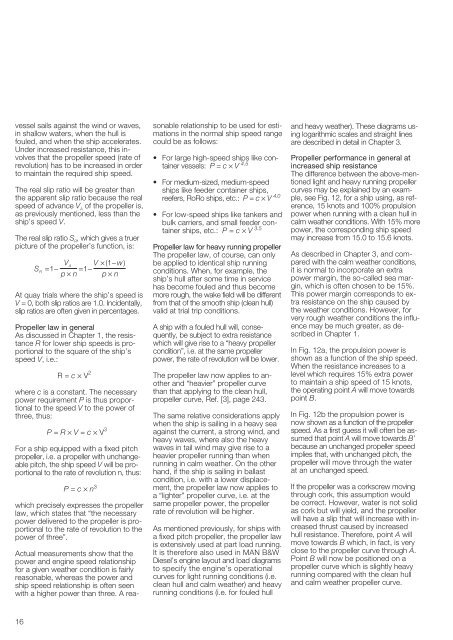
![Conceitos transmissao de dados .Sinais[.pdf]](https://img.yumpu.com/50982145/1/190x146/conceitos-transmissao-de-dados-sinaispdf.jpg?quality=85)
![Packages e interfaces[.pdf]](https://img.yumpu.com/50629553/1/190x134/packages-e-interfacespdf.jpg?quality=85)
